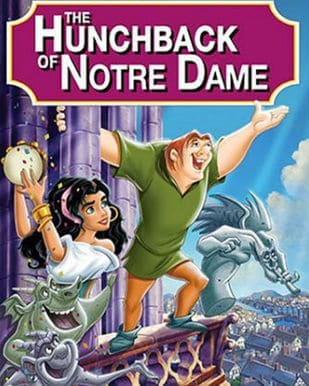
Welcome to Revisiting Disney! Today, we are looking at a surprising choice for an animated movie that, in a surprising turn of events, is less for children than typical Disney films, The Hunchback of Notre Dame! Like always, I have labeled each category so if you want to skip to the parts that interest you most, feel free. And, of course, if you have any thoughts, burning or otherwise, please share in the comments!
BACKGROUND OF THE HUNCHBACK OF NOTRE DAME
Released on June 21st, 1996, The Hunchback of Notre Dame is a Disney film that baffles me. Hear me out. It’s a gorgeous movie, with an amazing soundtrack, and I adore it. However, it is based on a very tragic and sad book. We’ll talk about that more below, but when it comes to deciding what should be made into a Disney movie, Victor Hugo’s The Hunchback of Notre Dame is not the first book that screams “Disney” to me, personally.
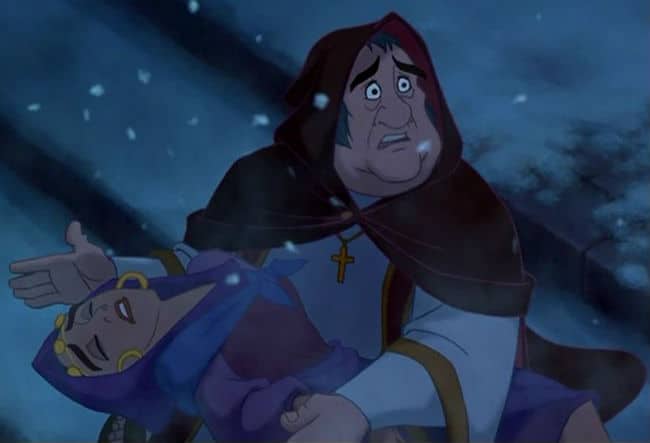
The directors behind The Hunchback of Notre Dame were Kirk Wise and Gary Trousdale, who had directed Beauty and the Beast, worked on the story for The Lion King, and would go on to direct and write Atlantis: The Lost Empire. Beauty and the Beast producer, Don Hahn, was also involved in this film.
I think that, in terms of comparing the films from the early years to the 1990’s, if Beauty and the Beast is the Pinocchio, and The Little Mermaid is the Snow White, this film is the Fantasia. The Hunchback of Notre Dame was an extremely risky film, mainly because it’s darker and grittier than typical Disney. Add Frollo’s obsession with Esmeralda, the opening murder/attempted murder and the genocide subplot, and you have a film that is really taking chances. Did it pay off? Yes, I think it did.
MUSIC
Although it did not win an Academy Award or an Oscar, The Hunchback of Notre Dame was nominated for both in 1997. The Academy Award was for Best Music, Original Musical or Comedy Score for Alan Menken and Stephen Schwartz, the team behind the music of Pocahontas. The Golden Globe nomination was for Best Original Score, Motion Picture for composer Alan Menken.

Even without winning any awards, however, the music in this movie is phenomenal. The chants that are in the film are based on actual chants, Gregorian chants specifically. This adds a sense of realism to the music. Between the care taken in this aspect of the music and the attention to detail in drawing the cathedral itself, there is a feeling of accuracy that raises the stakes, in some ways. Plus, the arrangements are stirring and wonderful; altogether, the music and the animation work well to influence the mood of the viewer.
Because of the dark nature of the scene, the song “Hellfire” was almost cut from the film. Even without cutting it, the Motion Picture Association of American required the Studio to redefine and emphasize the clothing that smoke-Esmeralda was wearing to keep the rating where it was.
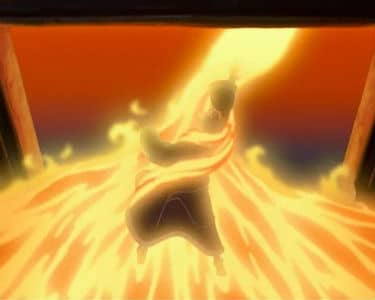
Altogether, the songs drive the plot forward in a wonderfully effective way. The music is, overall, epic, which is fitting given the scope and size of the backgrounds and the animation used in the film. It works well, and “God Help the Outcast” would go on to become an important part of show choir repertoire (for the casual concert end-of-year concert, at least).
ANIMATION
In Stephen Rebello’s The Art of the Hunchback of Notre Dame, he mentions that the animators had been “inspired by Hugo’s passion for accurate, dramatic, and highly evocative rendering of Gothic architecture,” that many people on the team went to Paris for ten days, and made several trips later on. The film also takes advantage of the newly opened (at that time) Disney Animation offices in Paris.
The amount of time spent in Paris really shows; the film has a feel of realism to it, and the team made that choice very deliberately, choosing to distance themselves from more fantasy-based pieces like Sleeping Beauty and Beauty and the Beast.
The team spent three days total touring Notre Dame itself. This guided tour included going places that most people don’t in the cathedral, hearing from historians how the cathedral would have been seen in Hugo’s day, and learning about the symbolism seen in Notre Dame.
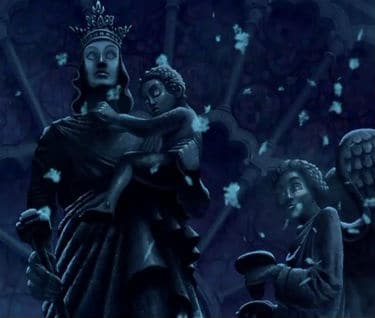
Notre Dame herself was animated in a very interesting way; the cathedral is shown as one of the characters, something the animators took directly from the text. This is fascinating to me because watching it again I can totally see it. Notre Dame reacts differently to the different characters – the lighting in the cathedral when Quasimodo is there is very different than the lighting when Frollo is there (showing that Notre Dame likes Quasimodo, not Frollo). In the end, even, when Notre Dame is under siege, the building seems to fight back!
To create the massive size and scope of Paris and her population, the animators made three-dimensional crowds, using the computer-generated software. Basically, The Hunchback of Notre Dame is a film that really took advantage of the new technology that it had access to, and also used the multiplane effect that had been developed for Pinocchio to great effect.

Little details, like the confetti in the Topsy-Turvy scene, were computer-generated. However, not only were the crowds created as computer animated beings, this new technology was used in the battle scene at the end of the film, and Rebello points out that it is “cutting edge,” while the directors joked that they were constantly trying to crash their computers. They never did, and the fight scene we got is better for the attempt at pushing the envelope.
THE PLOT
The film opens with a truly epic song, “The Bells of Notre Dame,” which serve to introduce us to our setting and many of our characters. It sets the stage for what is going to be, clearly, an epic tale. Our narrator, Clopin, the gypsy king, is telling a group of children about the beautiful bells that ring from Notre Dame, and their mysterious bell-ringer.
The story, Clopin continues, is one of a monster and a man. Who is who? We’ll find out, I’m sure. The story begins years earlier when a group of gypsies was trying to sneak into Paris without being caught by Judge Claude Frollo, who hated gypsies and was trying to cleanse the world.

He has the men arrested and brought to the palace of justice, but when they try to take the baby from the woman (thinking it’s something she stole), she runs for Notre Dame to seek sanctuary. However, Frollo catches her, grabs her bundle and kicks her down. She falls onto the steps and dies.
When Frollo realizes that the bundle was a baby and a misshapen baby at that, he decides to drop it down the well and be rid of it. However, the Archdeacon appears and stops him, pointing out that Frollo killed someone on the steps of the church, and reminds him that God knows and that the church itself was watching.
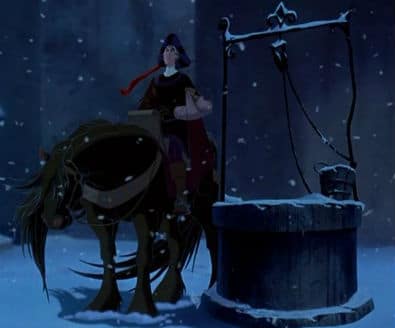
This gives Frollo some guilt, and when he asks what he can do, he finds out that he needs to raise the child as his own. He agrees, as long as the baby lives in the bell-tower of the church. He names him Quasimodo, which means half-formed. And this brings us back to the present.
Quasimodo has grown up to be a fairly kind person, despite his upbringing. As we see the way that Frollo and his ward interact, it’s amazing that Quasimodo has such a kind and loving heart.

Today, however, is a special day, the Festival of Fools. Quasimodo desperately wants to attend although it’s against Frollo’s rules and he gets in trouble for mentioning it. At the advice of three wisecracking gargoyles (who I read were designed to be a part of Notre Dame that protects and advises Quasimodo), Quasimodo realizes that he just wants one day to live outside of Notre Dame, and sneaks to the Festival anyway.
While Quasimodo has decided to sneak out to the Festival, Captain Phoebus has just arrived in the city, for a new position as Captain of the Guard. Having been gone for a few decades, he is having trouble finding the Palace of Justice. Running into a group of gypsies, he finds that their dancing is fun (plus, one of them is very pretty and there is a bit of a spark between them).
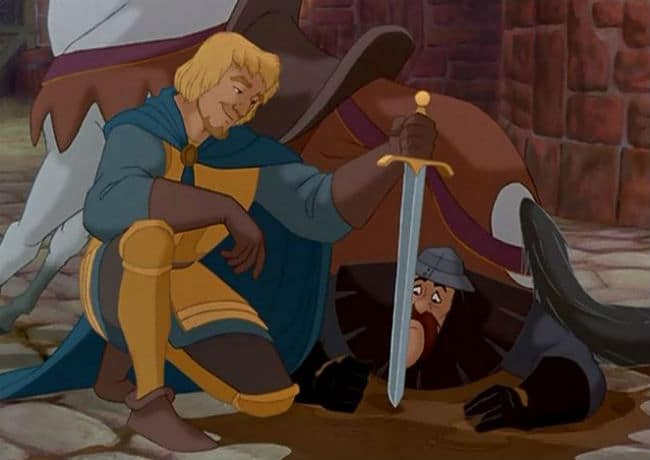
When a group of guards start to antagonize this gypsy girl, she is able to get away, though Phoebus steps in before they can chase her. Although they are upset, when he reveals his rank, the guards lead him to the Palace of Justice, while a pleasantly surprised Esmeralda (though we don’t know her name yet), watches.
Meeting his new employer, Minister Frollo, Phoebus is dismayed to learn that his job will be to catch gypsies since they are relatively harmless and he was fighting in an actual war before this. However, he is a soldier, so he knows his duty.
Going with Frollo, the two head to the Festival of Fools, where Quasimodo is trying to sneak into the crowd. Poor guy, though, he’s bad at the sneaking; Clopin and Esmeralda keep finding him and highlighting him.
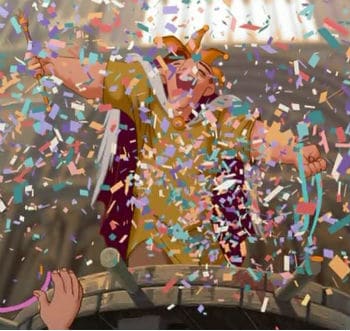
During the competition to see who the new King of Fools will be (the one with the ugliest face), Quasimodo is revealed to be the bell-ringer of Notre Dame. Although at first the crowd loves him, when two guards start to throw produce at him, the mood of the crowd quickly turns.
Tying him down, the crowd mocks him without mercy. Though Phoebus tries to save him, it is not until Esmeralda climbs up that the crowd stops jeering. Defining Frollo’s orders, she cleans him up, apologizes to him for the crowd’s behavior, and unties him.

Frollo is furious and orders Phoebus to arrest Esmeralda though she manages to escape and flees to the safety of Notre Dame. Meanwhile, Quasimodo has learned his lesson and will never go outside again. Walking through the horrified crowd, he escapes back into the safety of Notre Dame.
In Notre Dame, Phoebus finds Esmeralda and although they do fight and have a bit of banter, he is just trying to find out her name. She’s in the cathedral, so she’s safe. They’re an interesting romantic pair because they’re different than most Disney couples in terms of age and life experiences. They’re not typical, and it’s quite fun.
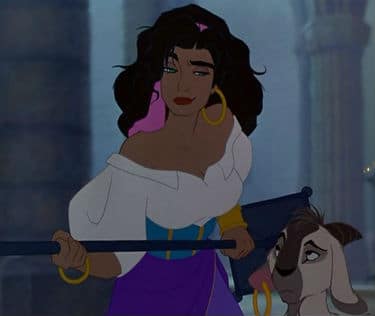
Frollo discovers them and tells Phoebus to drag her outside and arrest her there. Phoebus and the Archdeacon remind him that the claims of sanctuary must be honored, however, and the Archdeacon leads Phoebus to the door. Frollo lags behind, warning Esmeralda that gypsies don’t do well inside, and proceeds to post a guard at every door.
Esmeralda sings “God Help the Outcasts,” because the priest reminds her that she can’t right all the world’s wrongs, but someone in Notre Dame can. Quasimodo hears her, and when she sees him, chases him to his tower.
There, she apologizes to him for pulling him onto the stage and admires the view that he has. She admits that Frollo is right, though, and gypsies don’t do well when they feel trapped. Quasimodo realizes that not all gypsies are bad, and she tells him that he is not a monster. Quasimodo tells her that he can help her escape, and she asks him to come with her. He is too afraid to go with her, so she gives him a woven band to help him find sanctuary.

As Esmeralda escapes, Phoebus comes back to see if she’s okay. Quasimodo is angry at what he sees as a violation of sanctuary, but when Phoebus explains that he was just coming to apologize for trapping her there, Quasimodo relents a little bit. I don’t think they’ll ever be best friends, but there is a grudging respect here.
Quasimodo is falling in love with the lovely Esmeralda, and his song “Heaven’s Light,” leads into the song “Hellfire,” which Frollo sings. He has become obsessed with Esmeralda, and declares that she has tempted him (on purpose!) and he must have her. If he can’t, he will burn her at the stake. As the film continues, he shows that he will stop at nothing to catch her, and soon all of Paris is on fire. Phoebus watches, trying to just do his job while becoming increasingly uncomfortable with the situation.
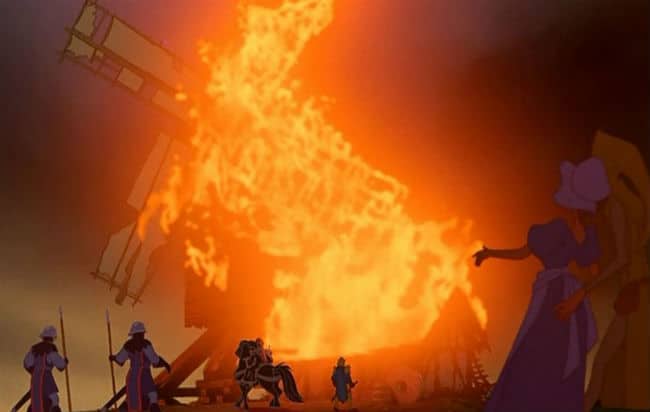
When Frollo orders him to burn down the home of the miller and his family, with them inside it, however, Phoebus can’t do it. Risking his life and his career, he goes into the building and saves them, only to be shot by Frollo’s troops. Esmeralda saves him and takes him to Quasimodo, the safest place in Paris.
Although he is crushed to learn that Phoebus and Esmeralda are in love, Quasimodo protects Phoebus, hiding him when Frollo comes to see him. Suspicious that Quasi knows where Esmeralda and the Court of Miracles (the gypsy hideout) are, Frollo tells Quasimodo that he is going to attack the Court at dawn. Phoebus and Quasimodo run to warn them, realizing that Esmeralda gave Quasi a map.
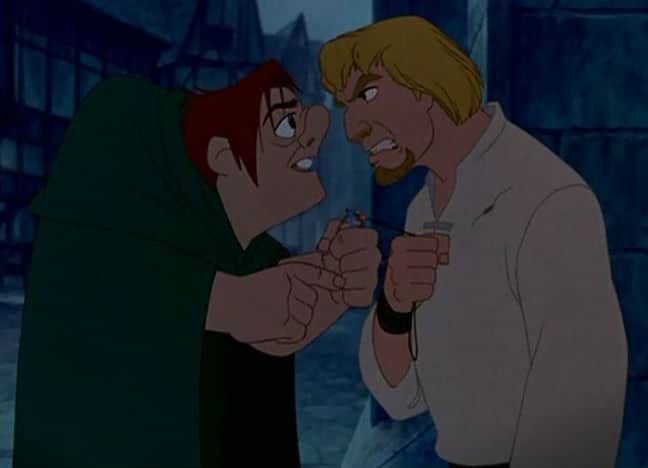
The gypsies have set up a defense, so when our heroes enter the Court of Miracles, they are captured by the gypsies. The gypsies recognize them as the Captain of the Guard and the Hunchback of Notre Dame, so decide that they must be working for Frollo. They are about to hang them when Esmeralda appears and tells her people the truth, that Phoebus saved the Miller’s family and that Quasimodo saved her life.
After they warn the gypsies and everyone begins planning to leave before Frollo can attack, they learn that Frollo lied. He has actually followed them to the Court and arrests everyone. He throws the gypsies and Phoebus into prison carts, chains Quasimodo to pillars in the bell-tower, and prepares to burn Esmeralda at the stake.
Offering Esmeralda one last chance, to choose him or to be burned, Frollo is again turned down. As they light the pyre, Quasimodo watches in sadness. The gargoyles try to convince him that he can save Esmeralda, but he refuses to listen until they tell him that they he was made of something stronger than stone.
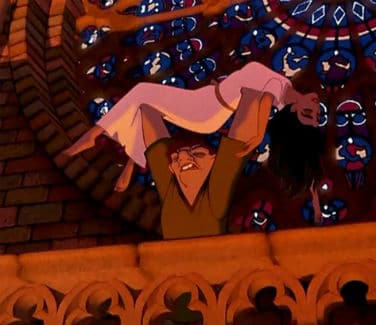
Suddenly enraged, Quasimodo realizes he can do something. Breaking his chains, Quasimodo swings down to save Esmeralda, carrying her back into Notre Dame and claiming sanctuary for her. Frollo orders his men to seize Notre Dame, but Quasimodo and the Cathedral itself fight back. Phoebus is able to escape and between his speech, Frollo’s attack of Notre Dame, and Quasimodo’s brave actions, the citizens of Paris begin to fight against Frollo and his men.
Frollo manages to get into Notre Dame during the fighting, where he finds Quasimodo weeping over the possibly dead body of Esmeralda. As Frollo comforts him, Quasimodo realizes that his master is trying to kill him, and has been keeping him locked up for years-Frollo is the real evil.
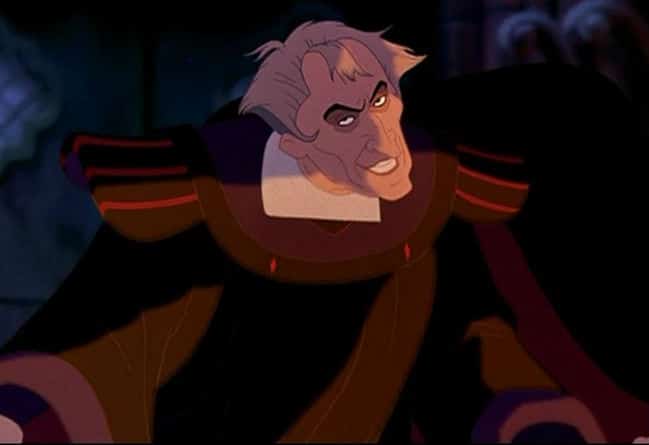
Fighting for their life, Quasimodo and Esmeralda (who is not dead! Hooray!) are trying to not be stabbed by Frollo, who has gone nuts at this point. They are hiding on the outside of Notre Dame, and Frollo’s attempts to kill them result in Frollo admitting that he killed Quasimodo’s mother, who died to save him.
Quasimodo falls but manages to catch onto Notre Dame. Unwilling to lose his father figure, though, Quasi saves Frollo, who takes advantage of the situation to swing to a nearby gargoyle. Quasi, however, faints at this point, and as Esmeralda is trying to haul him back onto Notre Dame, Frollo prepares to kill them both with one swing of his sword.
However, Notre Dame has, apparently, had quite enough of Frollo, thank you very much, and the gargoyle detaches from the cathedral, dropping Frollo into the fire. Unfortunately, not even Esmeralda can hold onto the unconscious Quasi for this long (especially because she was mostly dead five minutes ago), and he slips through her fingers as she screams. Luckily, Phoebus catches him.

Quasi realizes that Phoebus and Esmeralda are in love and a good match, so brings them together. As the pair steps out into the sun, the crowd cheers for Phoebus and Esmeralda, symbols of the victory against tyranny and hate. Esmeralda sees that Quasi is hiding in the shadows and brings him out into the crowd.
No one knows how to react to him until one of the kids Clopin has been telling his story to goes up to Quasi and hugs him. She then leads him into the crowd where everyone realizes that he’s not the monster they thought he was. The crowd also recognizes that Quasimodo is a human, just like them, and they accept him. What makes a monster and what makes a man? Not what’s on the outside.
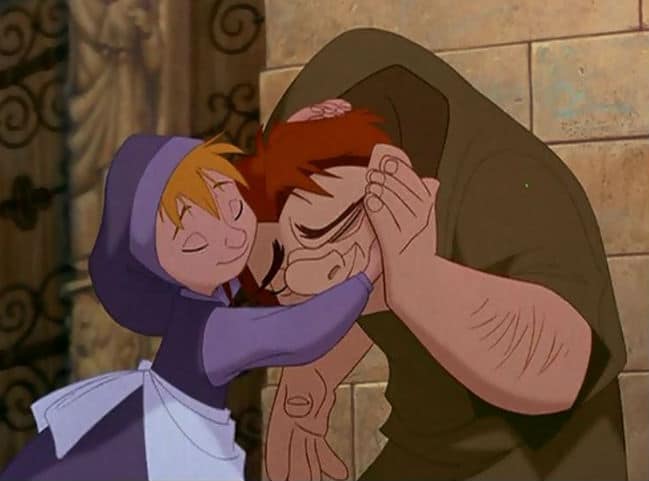
SOURCE MATERIAL
The Hunchback of Notre Dame is based on Notre Dame de Paris, a novel by Victor “I Don’t Write Happiness” Hugo, who also penned Les Miserables. Hugo is a genius, I’m not disputing that, but his work does run on the epic and depressing side. Published in 1837, The Hunchback of Notre Dame was and is a book that is talked about quite a bit, and has been made into several film adaptations (and several musicals).
The book focuses most on contrasts; light and dark, piety and real faith, good and evil, beauty and ugliness, what things seem to be and what they actually are, and other similar themes. Rebello argues that, in addition, Hugo’s novel divides Paris into three distinct places, Heaven in Notre Dame, Hell in the streets, and Quasimodo trapped somewhere in between.
Calling the book a “rousing historical romance and a psychodrama,” Rebello points out that Hugo had a lot of thoughts on political and social issues of the day, and used The Hunchback of Notre Dame to process those thoughts. These include modernization, the occult, alchemy, gypsies, and the issues facing a society that is consumed by feelings of guilt and sin.
The legend goes that Hugo wrote the story with just one bottle of ink, and in just six months. While that is technically true, he had been working on the research for the book for three years before he started writing. It was only when his publisher threatened to start charging him for every week the book was late that he finished it.
The research aspect that went into this book really shows, and although it was published with some negative reviews, overall, people liked it and it is still seen today as a literary masterpiece, one that conveys an amazing amount of raw, human emotion. The themes that Hugo uses are universal ones, and this is something that appealed to audiences both in 1837 and today.
I don’t want to spoil the book, but it’s really dark and there is no happy ending for anyone. Regardless of that, it’s still an amazing book but go into it knowing that it won’t have a happy ending.
The 1990’s
The 1990’s continue this week with 1996, and as seems to be a trend in the 1990s, there are some pretty bad things happening. First of all, in the United States, a bomb was detonated at Olympic Park in Atlanta, GA. Someone is killed, and no one is ever charged. Additionally, this is the year that The Unabomber, Theodore Kaczynski, is arrested. He had been using mail bombs, killing three people and injuring multiple others. The US also backs up a bit on our sanctions against Cuba, and the stock market grows at an alarming rate.
In the rest of the world, things are also happening. The Taliban captures the city of Kabul, declaring Afghanistan to be a Fundamentalist Islamic State while Osama Bin Laden is kicked out of Sudan and moves to Afghanistan. There is also a massacre in Scotland, the Dunblane Massacre, where a class of 5 and 6-year-olds is massacred. One child survived, but the other 15 (plus the teacher) died at the scene. There were also 600 deaths in Bangladesh due to thunderstorms and a tornado, Britain gets hit by Mad Cow disease, and a category 4 cyclone hits India, killing over 2000 people.
Positive things were happening, though! Divers in Egypt discovered the port city of Alexandria and France stopped Nuclear testing in the Pacific Ocean. Also, major league soccer really kicked off this year, the Nintendo 64 was released in Japan, and the UN and experts from Iraq take down a biological weapons factory in Iraq.
I feel like this is a good climate for a movie that talks about such stark contrasts, mostly because the characters (and, therefore, the audience) are forced to wrestle with these issues. What does it all mean? When do we have to fight for what is right? What does an abuse of power look like? These are all questions that, I think, The Hunchback of Notre Dame addresses, and the world climate definitely influenced the way those questions were asked.
LESSONS LEARNED
The lessons learned in The Hunchback of Notre Dame are interesting, to me. Of course, we have the lesson of not judging people by their appearance; beauty is found within (though Esmeralda and Phoebus are both attractive people who are also good people, so that is an interesting contrast).
There is also the lesson of knowing when it is time to stand up and fight for what’s right. True, it takes Paris burning to the ground for her citizens to finally fight, but it happens. Phoebus tries to do his job, but when faced with killing an innocent family, he draws his line in the sand. Esmeralda says Quasimodo from the mob, and Quasimodo saves her from her death.
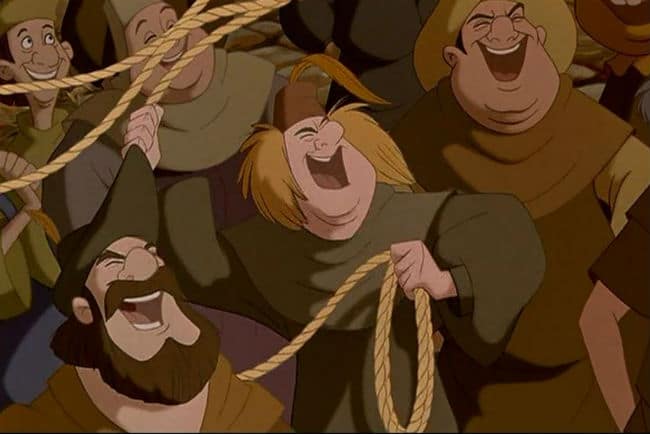
There’s also something in here about the mob mentality. Large groups of people can be easily swayed, especially when they are motivated by fear and things they don’t understand, like how Quasimodo looks scary but actually isn’t. The scene where the mob turns on him, all of a sudden, is a really sad look at how quickly we as a group can change our minds.
Another lesson is that yes, some groups have swindlers and cheats in them, but not everyone is the same. Esmeralda earns her money and so do other gypsies. Some are thieves, but not all of them. Frollo’s hatred against a specific group of people is portrayed as an obsessive hatred that leads him to genocide, and in the end, the citizens of Paris (including the gypsies) fight together against him.
My favorite lesson is one from the beginning, life is not a spectator sport. It’s short and sweet.
Finally, power can corrupt. Frollo used his power to try to exterminate an entire group of people.
It’s also a great film in that all the characters are complex and feel real. They all struggle with their choices and where they feel that they are trapped, having to make decisions and live with the consequences of those actions.
DOES IT HOLD UP?
I didn’t watch The Hunchback of Notre Dame much as a kid, because it’s kind of creepy, dark, and depressing, and seems to not really be for kids. However, watching it again this week reminds me of just how gorgeous this movie looks and sounds. Loved by many, even though the ending is nothing like the book, The Hunchback of Notre Dame is fabulous (not something I say often). With the source material and the gritty sense of realism that Disney seems to have been going for here, The Hunchback of Notre Dame might be one of the more risky animated projects Disney has made (at least in the top five), and I think it really pays off.
For next week: Hercules
If you enjoyed this post and the others in the Revisiting Disney series, and have found yourself wishing that you could find them all in one convenient and bound book with eight extra essays, there is an option for you! Check out A Journey Through Disney: My Look Back Through Disney Canon, now available on Amazon as both a Kindle book ($4.99) and a paperback ($11.99).
Photos: Disney
OTHER SOURCES:
https://thewaltdisneycompany.com/about-disney/disney-history
http://www.imdb.com
http://studioservices.go.com/disneystudios/history.html
http://www.thepeoplehistory.com/1996.html
http://www.kidzworld.com/article/4255-1990s-timeline
Bailey, Adrian. Walt Disney’s World of Fantasy. Everest House Publishers. New York, New York. 1982.
Finch, Christopher. The Art of Walt Disney: From Mickey Mouse to the Magic Kingdom. Harry N. Abrams, Inc. New York, New York. 1975.
Johnston, Ollie and Frank Thomas. The Disney Villain. Hyperion. New York, New York. 1993.
Rebello, Stephen. The Art of The Hunchback of Notre Dame. Hyperion. New York, New York. 1996.
Sale, Roger. Fairy Tales and After: From Snow White to E.B. White. Harvard University Press. Cambridge, MA, 1978.
Tatar, Maria. The Annotated Classic Fairy Tales. W.W. Norton and Company. New York and London, 2002.
Thomas, Bob. Disney’s Art of Animation From Mickey Mouse to Hercules. Hyperion. New York, New York. 1992.
Wright, Gordon. The Ordeal of Total War: 1939-1945. Harper Torchbooks, Harper & Row. New York, Hagerstown, San Francisco, and London, 1968.
ARE YOU A ROMANCE FAN? FOLLOW THE SILVER PETTICOAT REVIEW:
 Our romance-themed entertainment site is on a mission to help you find the best period dramas, romance movies, TV shows, and books. Other topics include Jane Austen, Classic Hollywood, TV Couples, Fairy Tales, Romantic Living, Romanticism, and more. We’re damsels not in distress fighting for the all-new optimistic Romantic Revolution. Join us and subscribe. For more information, see our About, Old-Fashioned Romance 101, Modern Romanticism 101, and Romantic Living 101.
Our romance-themed entertainment site is on a mission to help you find the best period dramas, romance movies, TV shows, and books. Other topics include Jane Austen, Classic Hollywood, TV Couples, Fairy Tales, Romantic Living, Romanticism, and more. We’re damsels not in distress fighting for the all-new optimistic Romantic Revolution. Join us and subscribe. For more information, see our About, Old-Fashioned Romance 101, Modern Romanticism 101, and Romantic Living 101.

Comments are closed.